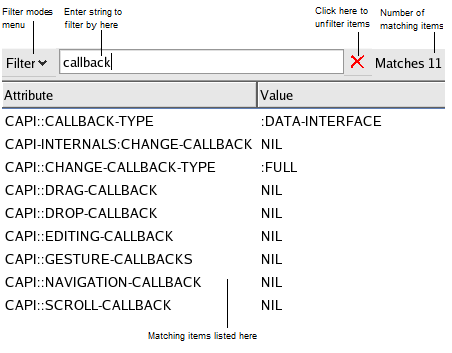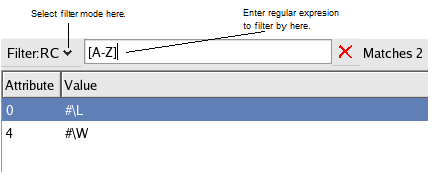





3.12 Filtering information
Many tools have views which display information in a list. Items in these lists may be selected, and you can usually perform operations on selected items (for instance, by means of the standard action commands, as described in Performing operations on selected objects).
Such lists are often long, including information which you are not interested in. For instance, Common Lisp objects may contain a large number of slots, most of which are of no importance to your work.
Most such lists in the LispWorks IDE have a filter area which allows you to hide the uninteresting information. The filter area is above the list, and consists of the Filter pane into which you can enter text, toolbar buttons, and the Matches pane. There is also a filter modes dropdown menu, described in Advanced Filtering.
3.12.1 Plain Filtering
This section describes how you can filter list items based on a substring match.
Figure 3.9 Filter area with plain match
To use the filter, simply enter text in the box to the right of the
Filter
modes menu button. The list is filtered automatically as you type. Only those items that contain the specified string are displayed in the list - all the others are hidden from the display. The number of items that are listed is printed in the
Matches
area to the right of the Filter box.
To display all the items in a list once again, delete the string in the
Filter
box or click the  button.
button.
3.12.2 Advanced Filtering
This section describes how you can filter list items by a regular expression match rather than a plain string match, make the match case-sensitive, and how to invert the filter.
To alter the way that the filter operates, select one or more options from the
Filter
dropdown menu to the left of the filter pane. You can select this filter modes menu using the mouse, but is more convenient with a keyboard gesture. Each gesture selects or deselects one filter mode. The keyboard gestures invoking advanced filter modes are shown in Advanced Filter modes.
Advanced Filter modes
|
Keyboard gesture
|
Filter mode
|
Description
|
|
Ctrl+Shift+R
|
Regexp Search
|
Filters by regular expression matching
|
|
Ctrl+Shift+E
|
Exclude Matches
|
Excludes items matching the filter
|
|
Ctrl+Shift+C
|
Case Sensitive
|
Filters by a case-sensitive comparison
|
The choice of items displayed changes according to the content of the filter pane and the selected filter options. The label on the
Filter
dropdown changes to indicate your selected filter options.
In the example illustrated below, we have inspected the string "LispWorks", entered a regular expression which matches uppercase characters, and pressed Ctrl+Shift+R Ctrl+Shift+C to select the
Regexp Search
and
Case Sensitive
filter modes.
Figure 3.10 Filter area with regular expression match
Now press Ctrl+Shift+E to select the
Exclude Matches
filter option. Only the lowercase characters of the string "LispWorks" are displayed in the list.
Note: For details of the regular expression syntax, see Regular expression syntax.
Note: The three filter modes are mutually independent.
LispWorks IDE User Guide (Unix version) - 12 Feb 2015








 button.
button.





